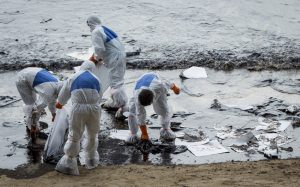A federal judge earlier this month ordered the EPA to update a decades-old regulation that currently allows the use of toxic chemicals in cleaning up offshore oil spills.
“The agency ‘delayed unreasonably’ by waiting at least six years to finalize draft regulations updating the 1994 rules, said William H. Orrick, a judge in the U.S. district court for the Northern District of California,” according to NBC Bay Area. “The EPA now has a deadline of May 31, 2023, to take final action on listing and authorizing the chemicals and in the meantime must submit regular status reports, Orrick ruled.”
The lawsuit was originally filed on January 30, 2020, in the “U.S. District Court for the Northern District of California by Earth Island Institute’s ALERT Project, Alaska Community Action on Toxics, Cook Inletkeeper, the Center for Biological Diversity, an Alaskan Native health aide and a Gulf Coast commercial fisher,” according to the Center for Biological Diversity.
Earth Island Institute filed for summary judgment based on claims that the EPA “failed to perform a nondiscretionary duty to issue a final rule to update Subpart J of the National Contingency Plan (NCP) as required by the Clean Water Act (CWA) regarding, among other things, the removal of oil and hazardous substances after oil spills, and violated the Administrative Procedure Act (APA) because of its unreasonable delay,” the summary judgment motion response notes.
“Instead of mitigating environmental harm, chemical dispersants have proven—when mixed with oil—to be more toxic to humans and the environment than the oil alone,” says the Center for Biological Diversity. “In the 2010 BP Deepwater Horizon disaster, coastal communities along the Gulf of Mexico, many of which were communities of color and/or low income, suffered from serious dispersant-induced health effects.
“First responders to the spill, including many Coast Guard workers, suffered negative health impacts,” states the Center for Biological Diversity’s press release on the ruling. “Their ailments included respiratory problems, severe skin blistering and other debilitating conditions, some of which persist to this day.”
Orrick ruled the EPA violated the CWA because it has “not amended the relevant portion of the NCP, Subpart J since 1994” in spite of “new information” that made it mandatory for the EPA to exercise its duty to update the regulation, according to the order granting summary judgment. The ruling also states the EPA violated the APA because it has yet failed to finalize regulations drafted in 2015.
“Dr. Riki Ott, director of Earth Island Institute’s ALERT Project, the lead plaintiff in the case, was a commercial fisher and marine toxicologist who witnessed firsthand the health and environmental impacts of the dispersants in the nation’s two largest maritime oil disasters,” according to the Center for Biological Diversity.
“In 1989, Exxon Valdez response workers called the ubiquitous cold- and flu-like symptoms among frontline workers ‘the Valdez Crud.’ Two decades later, the BP Deepwater Horizon disaster response workers called the same symptoms ‘the BP Syndrome.’ It turned out that these symptoms were early warnings of chemical illnesses that often led to disabling diseases, cancers and early deaths,” Ott says. “Exposed children were among the victims. This ruling means we just might be able to prevent a similar human health tragedy during the next big oil spill.”
In a previous June 2020 ruling in this case, Orrick decided the CWA “imposes on the EPA a mandatory duty to maintain an up-to-date oil spill response plan that reflects current science and technology. This includes science demonstrating that dispersant chemicals are far more toxic to humans — and more ecologically damaging — than their manufacturers admit,” says the Center for Biological Diversity.

